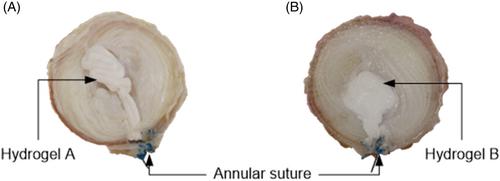Nucleus replacement devices (NRDs) are not routinely used in clinic, predominantly due to the risk of device expulsion. Rigorous in vitro testing may enable failure mechanisms to be identified prior to clinical trials; however, current testing standards do not specify a particular expulsion test. Multiple methods have therefore been developed, complicating comparisons between NRD designs. Thus, this study assessed the effectiveness of four previously reported expulsion testing protocols; hula-hoop (Protocol 1), adapted hula-hoop (Protocol 2), eccentric cycling (Protocol 3), and ramp to failure (Protocol 4), applied to two NRDs, one preformed and one in situ curing.
Nucleus material was removed from 40 bovine tail intervertebral disks. A NRD was inserted posteriorly into each cavity and the disks were subjected to one of four expulsion protocols.
NRD response was dependent on both the NRD design and the loading protocol. Protocol 1 resulted in higher migration and earlier failure rates compared to Protocol 2 in both NRDs. The preformed NRD was more likely to migrate when protocols incorporated rotation. The NRDs had equal migration (60%) and expulsion (60%) rates when using unilateral bending and ramp testing. Combining the results of multiple tests revealed complimentary information regarding the NRD response.
Adapted hula-hoop (Protocol 2) and ramp to failure (Protocol 4), combined with fluoroscopic analysis, revealed complimentary insights regarding migration and failure risk. Therefore, when adopting the surgical approach and animal model used in this study, it is recommended that NRD performance be assessed using both a cyclic and ramp loading protocol.



